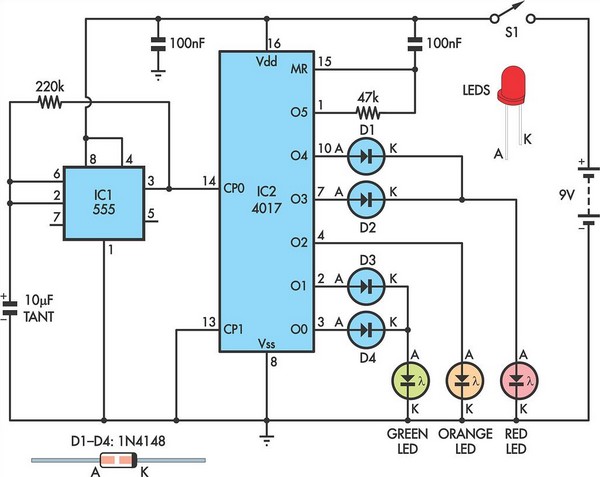Home » Circuits
Traffic Lights For Model Cars Or Model Railways
Kids these days seem to have most things you see in the toy shops, so if you have a son or grandson who has a collection of cars, here is something he will really appreciate. And it will be really special as you will be giving something made by you - a set of traffic lights for his cars. This traffic light circuit uses a 555 timer IC as the master timer. The 220kO timing resistor and 10µF capacitor control the timing pulses, giving a period of about three seconds. The 3-second output pulses are used to clock a 4017 decade counter whose outputs directly drive the green, orange and red LEDs. To obtain a longer time for the red and green lights compared with the orange light, two outputs are ORed using 1N4148 diodes for the red and green LEDs, while the orange is driven by one output only.This gives about 6 seconds for the red and green LEDs and 3 seconds for the orange. When power is first applied, the RC network connected to pins 1 and 15 of IC2 resets the 4017 and the green LED cycle begins. The orange and red cycles follow and at the end of the red cycle, pin 1 will go high to reset the 4017 to start the green cycle all over again. You can experiment with the cycle times by adjusting the 220kO resistor or by combining more or less 4017 outputs to achieve different ON times for the three LEDs.
Circuit diagram:
The circuit is designed to be powered by a 9V battery and this is the maximum voltage that is recommended. This is because the LEDs are directly driven by the 4017 with no current limiting resistor being used. The 4017 naturally limits the current that it can supply to 15mA. An extension of this project would be to make a second set of lights for the cross traffic. Here you would use the same 555 as a master timer for both sets of lights (otherwise chaos would ensue) and a separate 4017 to drive the three extra LEDs. Of course, you would have to take care and ensure that green and orange outputs on each set of lights correspond with red on the other!
Author: Jack Holliday - Copyright: Silicon Chip Electronics

